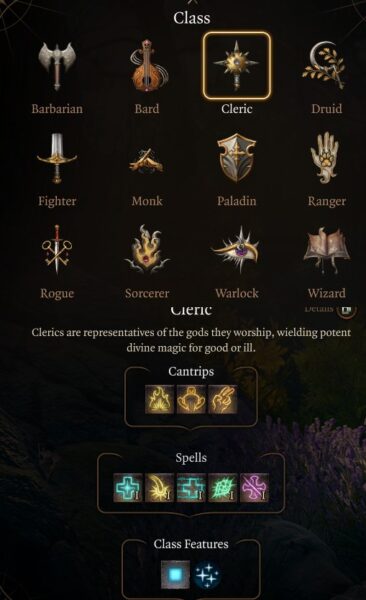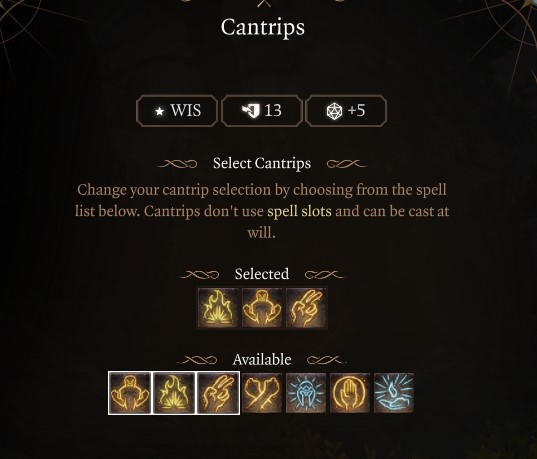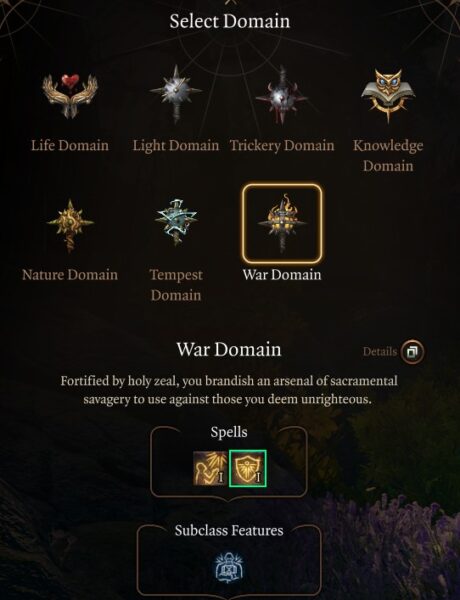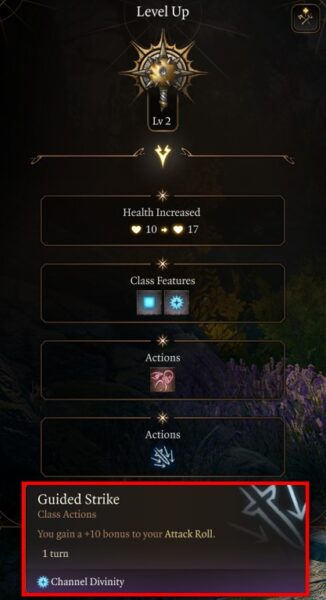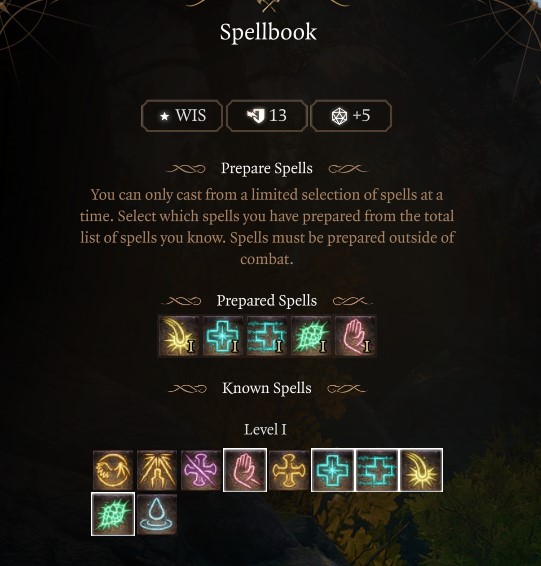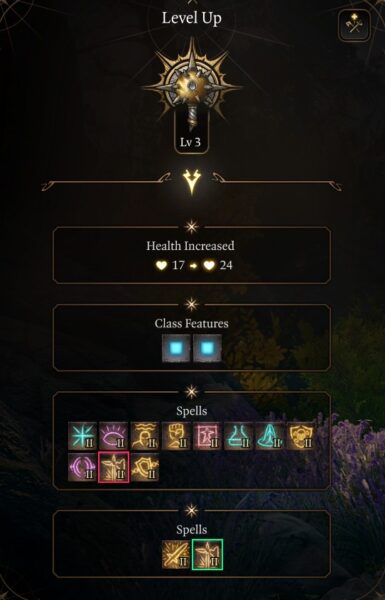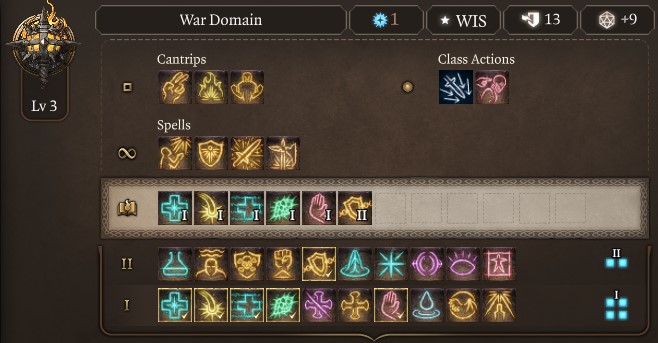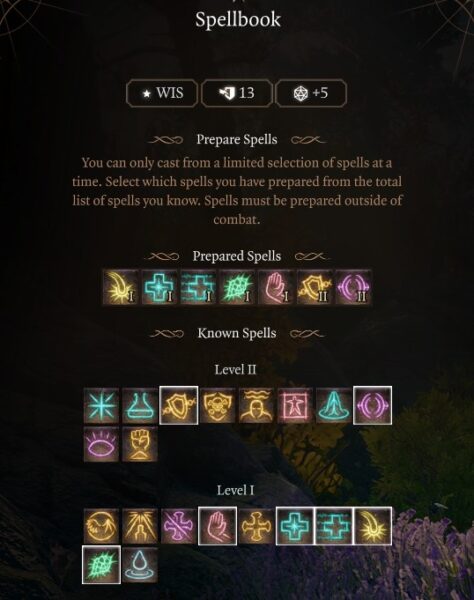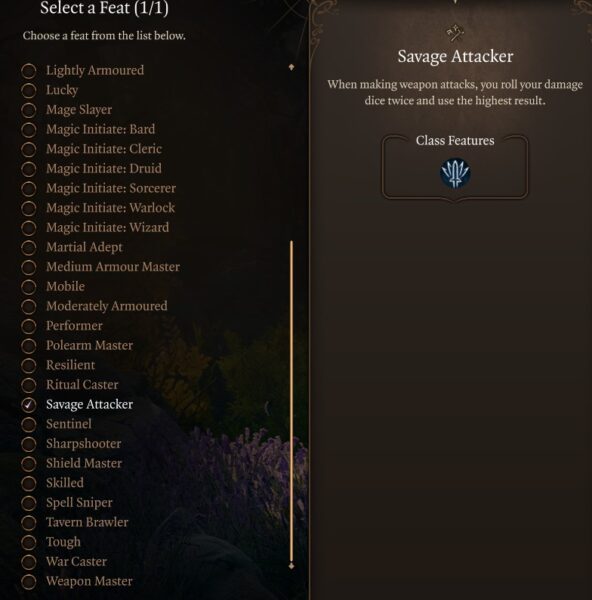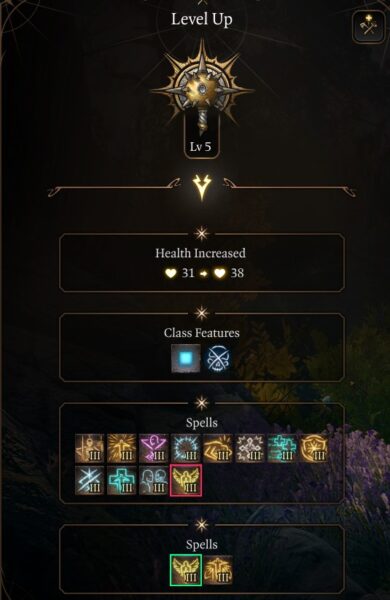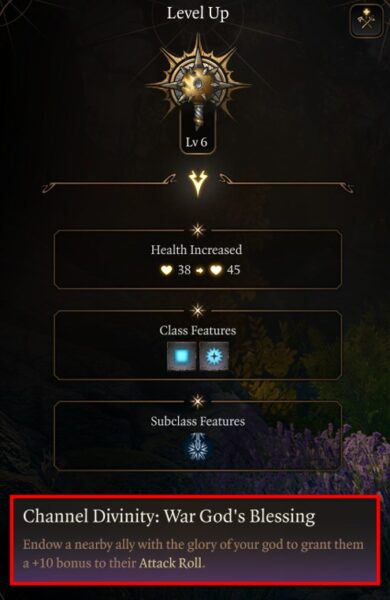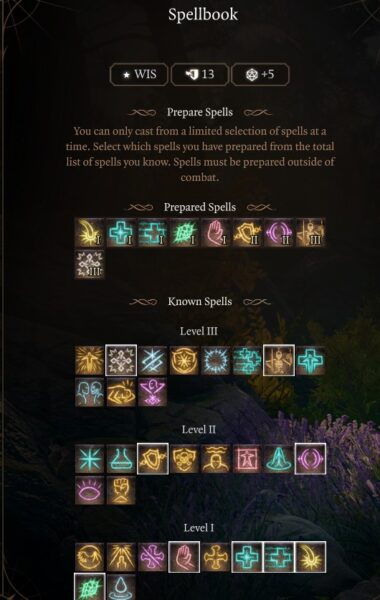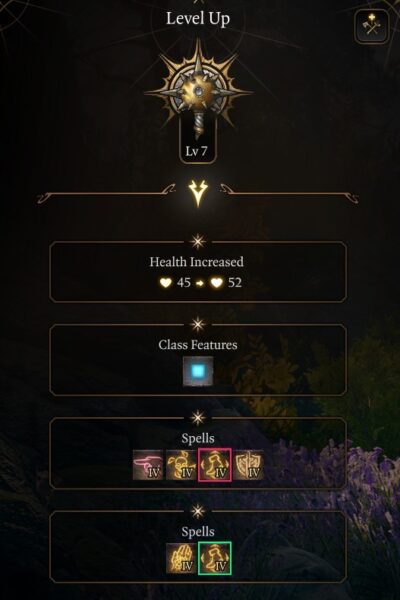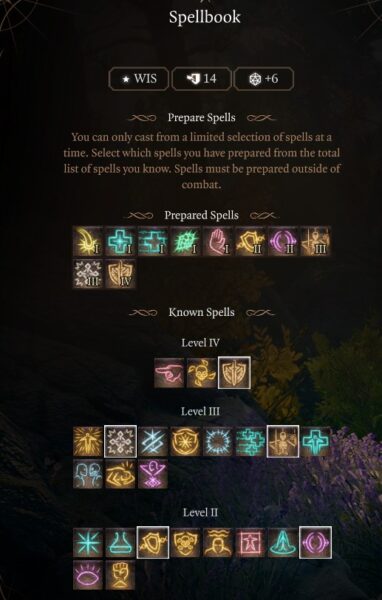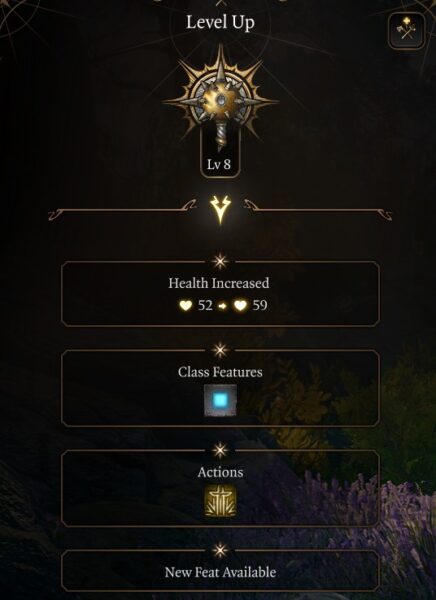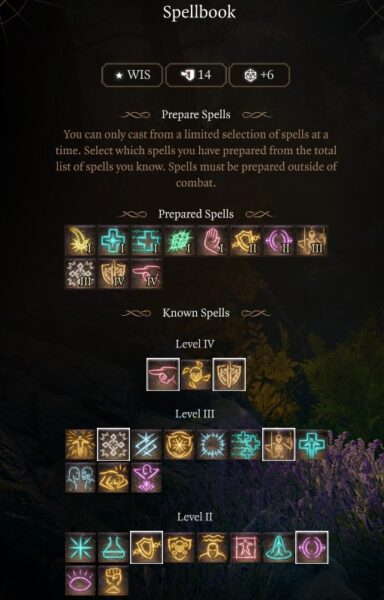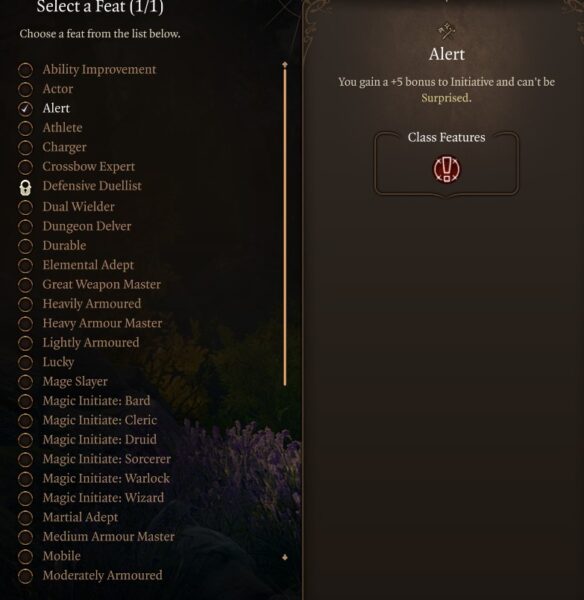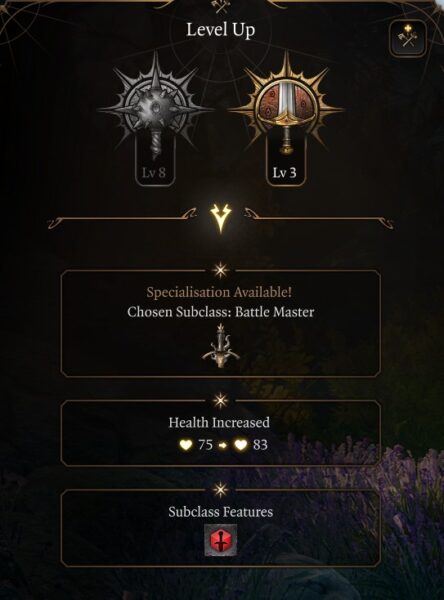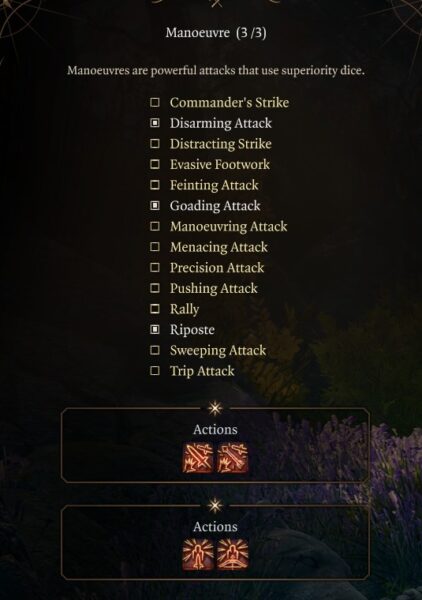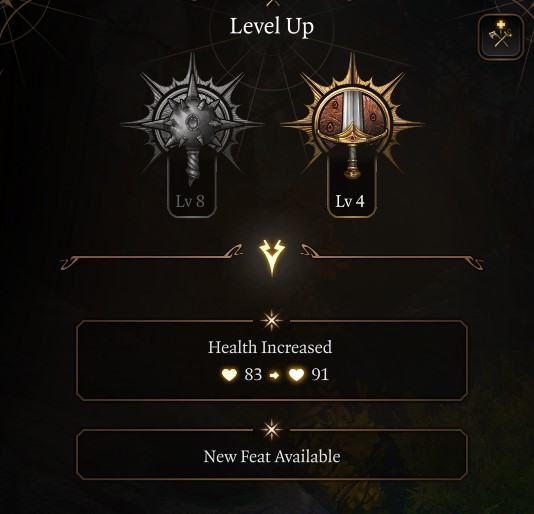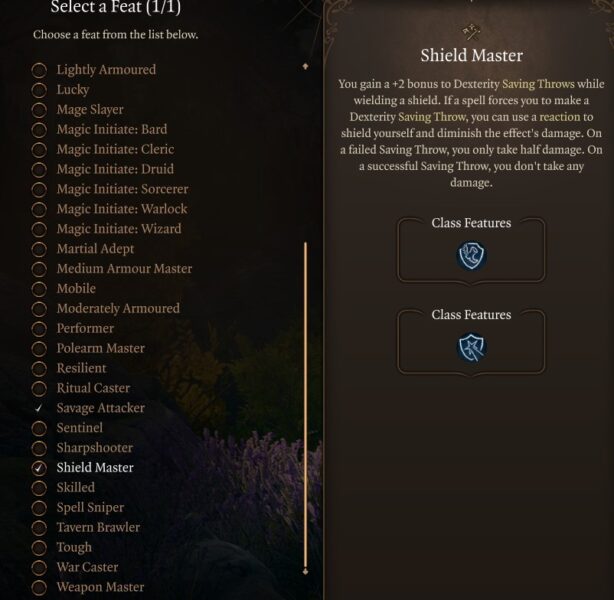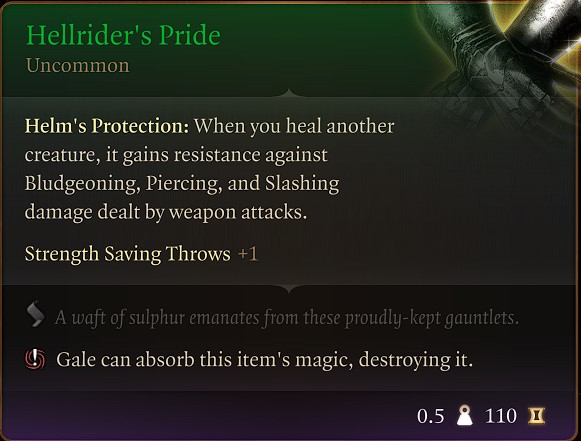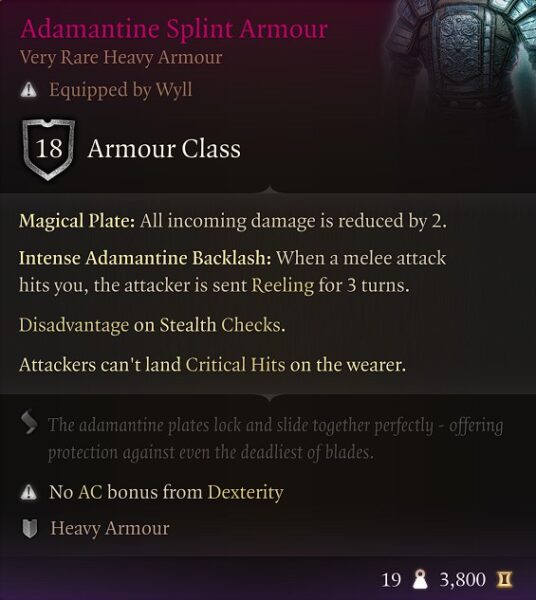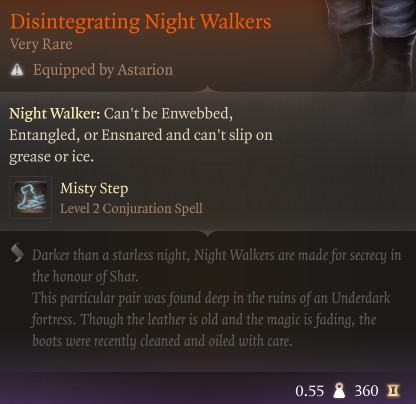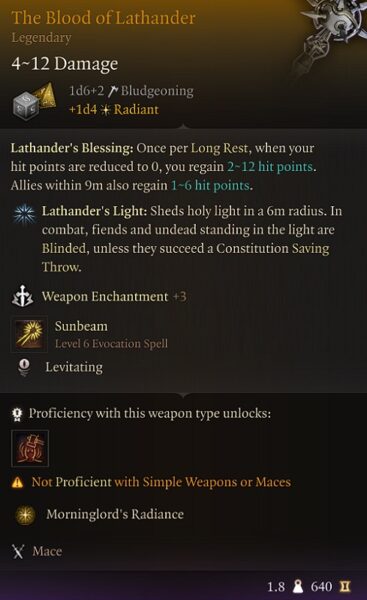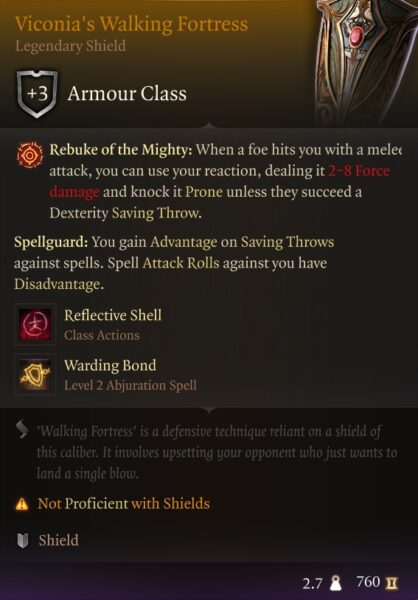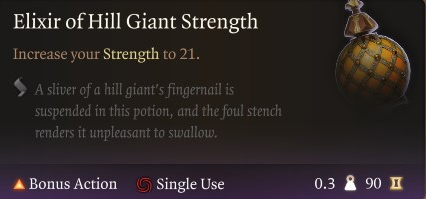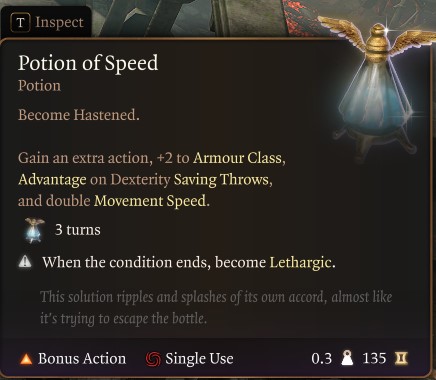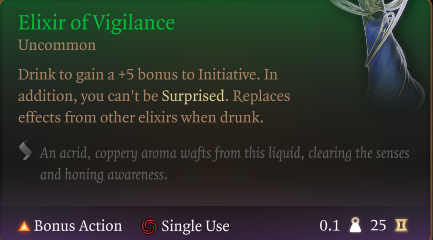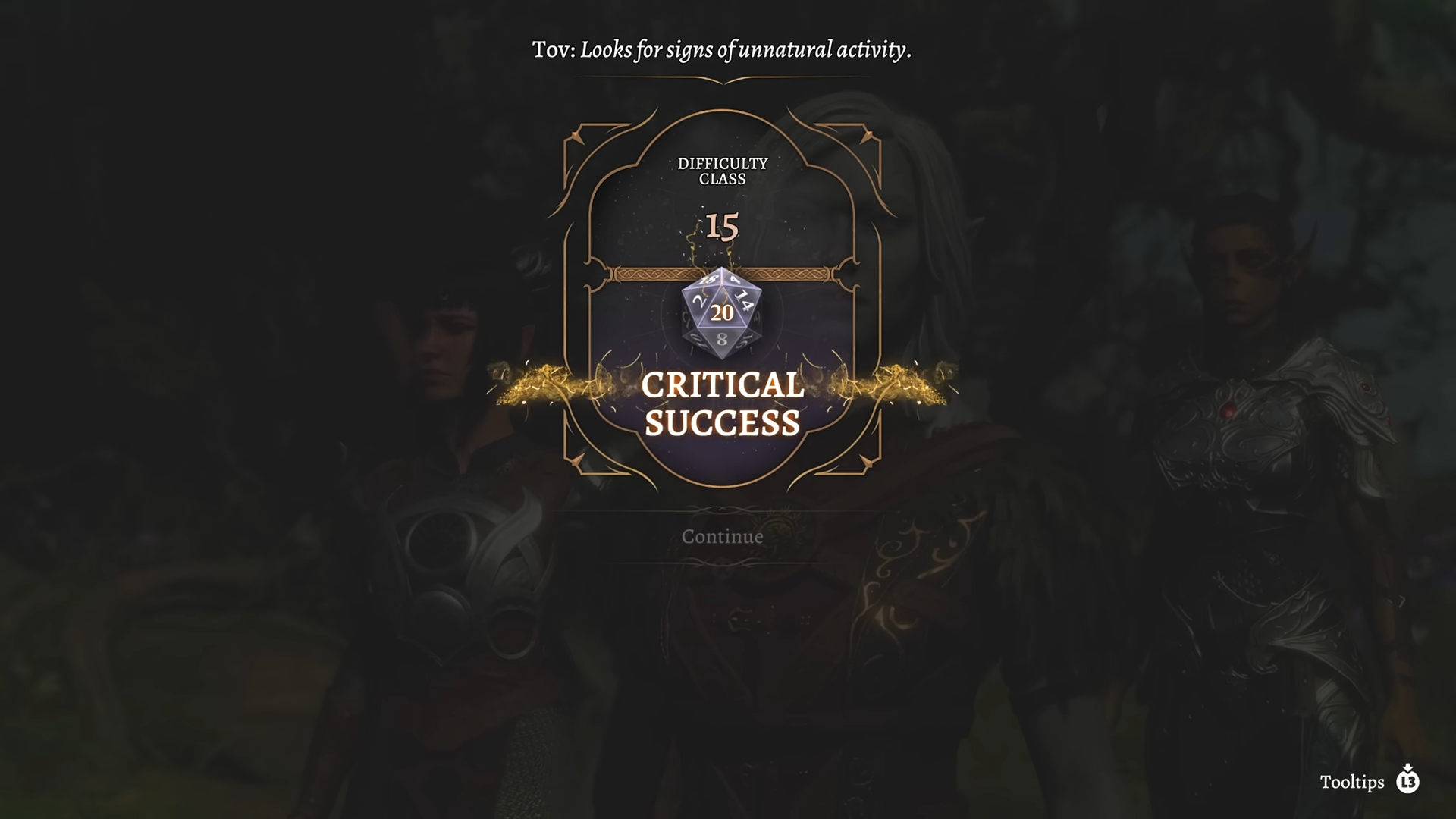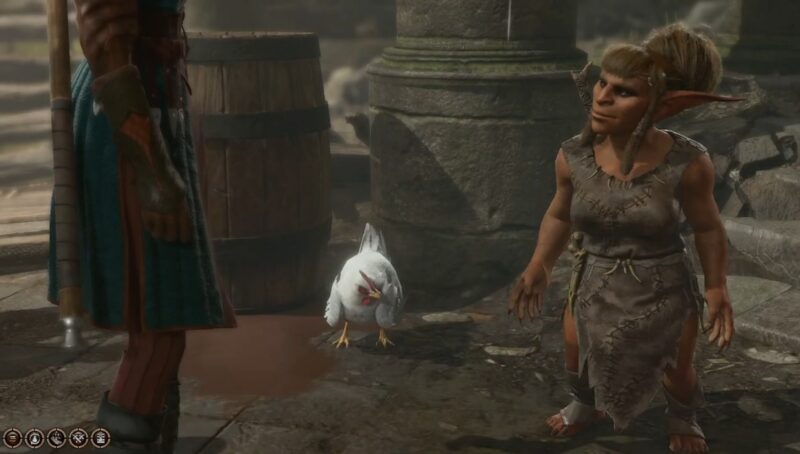This guide will explain the best Baldur’s Gate 3 Cleric War Domain Build Guide, and how to set up your character with abilities, skills, and gear.

This build page has been updated for the Patch 8 version of Baldur’s Gate 3.
Everything About the War Domain Cleric in Baldur’s Gate 3
In Baldur’s Gate 3 the War Domain is a subclass of Cleric that specializes in martial combat, tactics, and divine blessings related to warfare and battle. Consequently, this subclass is typically associated with gods of war, valor, and conflict.
This War Domain Cleric build is designed to be a heavy armor front-line damage dealer. With high Strength and Charmisa, you will play differently than other Cleric builds. Using weapon attacks and taking advantage of a unique subclass feature that allows you to attack with bonus action. This isn’t your typical Cleric support build, but blending offensive spells, weapon attacks, and outside-of-combat utility.
| War Cleric Pros | War Cleric Cons |
|---|---|
| Bonus Action Efficient | Must Use Strength Ability |
| Spells & Weapon Damage | No Extra Attack |
| Heavy Armor Proficiency | Weak Mobility |
War Domain Cleric Build Changes in Patch 8 for BG3
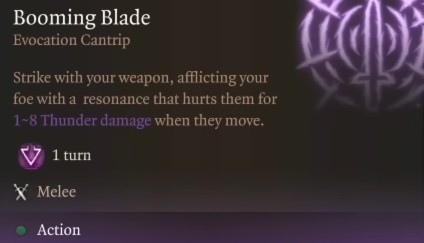
Patch 8 of Baldur’s Gate 3 introduces the Booming Blade cantrip for Clerics, adding a new layer of power for melee-oriented builds. This spell deals bonus damage when enemies move after being struck, making it ideal for aggressive frontline combat. While any combat-focused Cleric can benefit, the Death Domain makes the most of it thanks to martial weapon proficiency and bonus necrotic damage, turning them into formidable melee spellcasters.
Despite this addition, the core Cleric roles (healer, tank, and radiant damage dealer) remain largely unchanged. However, with tougher enemies in Tactician and Honour Modes, survivability has become more important than ever. For players seeking a sturdier option, the Light Domain offers a strong alternative, which we will detail below.
War Domain Cleric Class Mechanics and Features

The following list are key features and class mechanics of the War Domain Cleric in Baldur’s Gate 3:
- Primary Ability: Wisdom
- Secondary Ability: Strength
- Saving throw proficiencies: Wisdom, Charisma
- Subclass: War Domain
- Weapon Proficiency: Simple and Marital Weapons
- Armour Proficiency: Light, Medium, and Heavy Armor, Shield
- Preferred Weapon: Mace and Shield
- Preferred Armor: Heavy
- Guided Strike: Gain a +10 bonus to your Attack Roll.
- Turn Undead: Undead that can see or hear you are forced to flee from you
Cleric Spell Mechanics
- Cantrips: are like spells, but you can cast them infinitely, and they don’t take your spell slots.
- Spell Slots: At each level, you gain access to more usage of spells and high-tier spells but only have a finite number of spells until a long rest.
- Prepared Spells: this allows you to flex in and out spells as long as you are not in combat.
- Concentration: is a spell mechanic that requires you to maintain concentration otherwise, the spell effect ends.
War Domain Cleric Subclass Explained
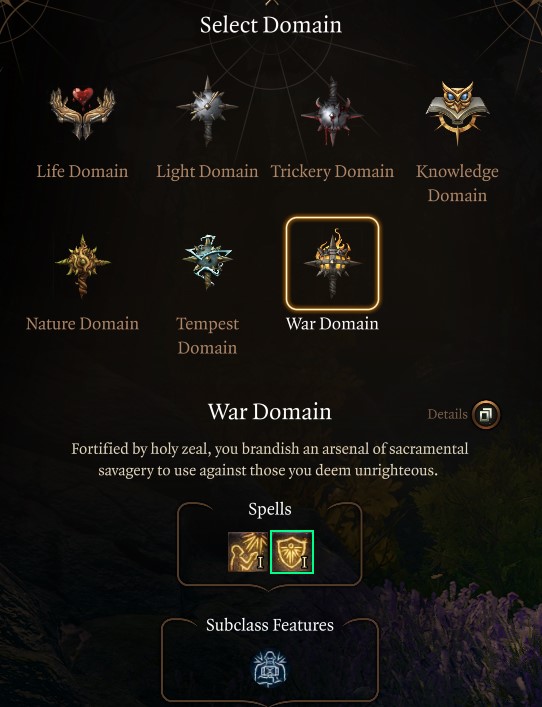
The War Domain Cleric is a subclass of the Cleric class in Baldur’s Gate 3. They are focused on martial combat, and their abilities allow them to deal more damage and stay in the fight longer. War Domain Clerics are proficient with all martial weapons and heavy armor, making them formidable combatants.
The War Priest feature allows War Domain Clerics to attack a bonus action on their turn. This helps the Cleric maintain pressure with action and bonus action. The Channel Divinity Guided Strike subclass feature allows the War Domain Cleric to give themselves +10 on Attack Roll. This is a great way to do a ton of damage with martial weapons while wielding powerful spells.
Below is a list of the War Domain Cleric subclass progression, features, and spells:
- War Priest (Level 1): When you make an unarmed or weapon attack, you can spend a War Priest Charge to make an additional attack as a bonus action.
- Heavy Armour Proficiency (Level 1)
- Martial Weapon Proficiency (Level 1)
- Domain Spells (Level 1): Divine Favour and Shield of Faith
- Channel Divinity Action (Level 2): Guided Strike – Reaction. You gain a +10 bonus to your Attack Roll.
- Domain Spells (Level 3): Magic Weapon and Spiritual Weapon
- Domain Spells (Level 5): Spirit Guardians and Crusader’s Mantle
- Channel Divinity Action (Level 6): War God’s Blessing – Endow a nearby ally with the glory of your god to grant them a +10 bonus to their Attack Roll.
- Domain Spells (Level 7): Stoneskin and Freedom of Movement
- Divine Strike: Warmaster (Level 8): Once per turn deal 1-8 in addition to your melee weapon damage.
- Domain Spells (Level 9): Flame Strike and Hold Monster
Character Creation
| Category | Selection |
|---|---|
| Character | Origin – Custom character |
| Race | Zariel Tiefling |
| Racial Bonus | Darkvision, Hellish Resistance, Smite spells |
| Class | Cleric |
| Subclass | War Domain |
| Cantrips | Sacred Flame, Guidance, Thaumaturgy |
| Spells | Guiding Bolt, Cure Wounds, Healing Word, Inflict Wounds, Command, Warding Bond, Silence, Animate Dead, Glyph of Warding, Guardian of Faith, Banishment |
| Background | Folk Hero |
| Ability Score | STR: 16 DEX: 10 CON: 14 INT: 8 WIS: 16 CHA: 10 |
| Skill Proficiencies | Medicine and Insight |
Recommended Backgrounds for War Domain Cleric
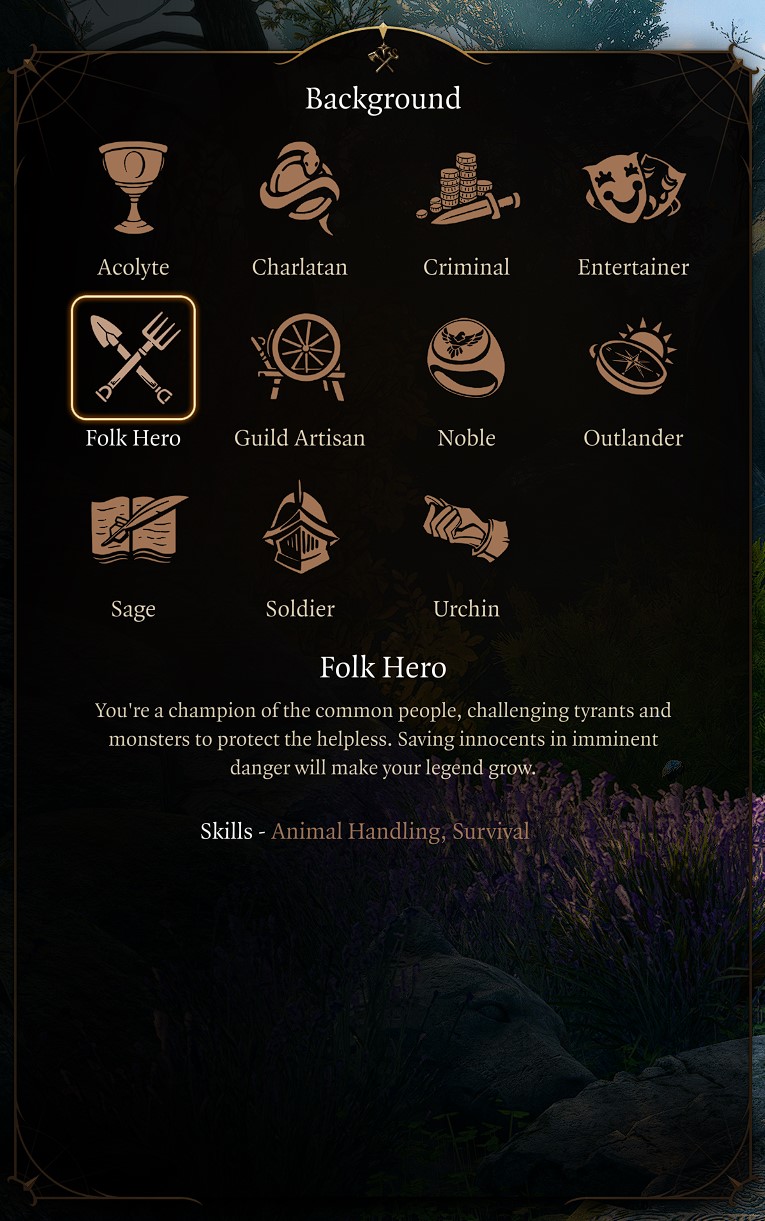
Folk Hero is the best background for the Baldur’s Gate 3 Cleric War Domain Build Guide because you gain proficiency in Animal Handling and Survival. You want to pick a background that scales with your main ability Wisdom. This choice mostly influences roleplaying and dialogue options aspects and allows you to create unique characters. Additional choices are:
- Folk Hero: Proficient in Animal Handling and Survival. You’re a champion of the common people, challenging tyrants, and monsters to protect the helpless.
- Acolyte: Proficiency in Insight and Religion. You have spent your life in service to a temple, learning sacred rites and providing sacrifices to the god or gods you worship.
Best Race Choice for War Domain Cleric

Zariel Tiefling is the Best Race Choice for a War Cleric Build because you gain two Smite Spells, Darkvision, and Fire Resistance giving you powerful offensive and defensive capabilities. However, a secondary choice is the Githyanki because of their inherent mobility skills and spells, as well as skill proficiency. Half-Orc is also a good choice for those who want a melee-only build.
Here is the best race choice for a War Cleric build in Baldur’s Gate 3:
| Zariel Tiefling | Githyanki |
|---|---|
| Darkvision (12m) | Astral Knowledge |
| Hellish Resistance | Githyanki Psionics |
| Searing Smite | Martial Prodigy |
| Branding Smite |
The Cleric’s racial choice will not influence ability score, as race will get a +2 and +1 to spend regardless. This frees your race choice up to not completely hinder yourself based on ability score, but race features. Each of these races offers unique advantages that can enhance your combat prowess, survivability, or utility. Additionally, consider the roleplaying opportunities and character concepts that resonate with you.
Recommended Skills for War Domain Cleric
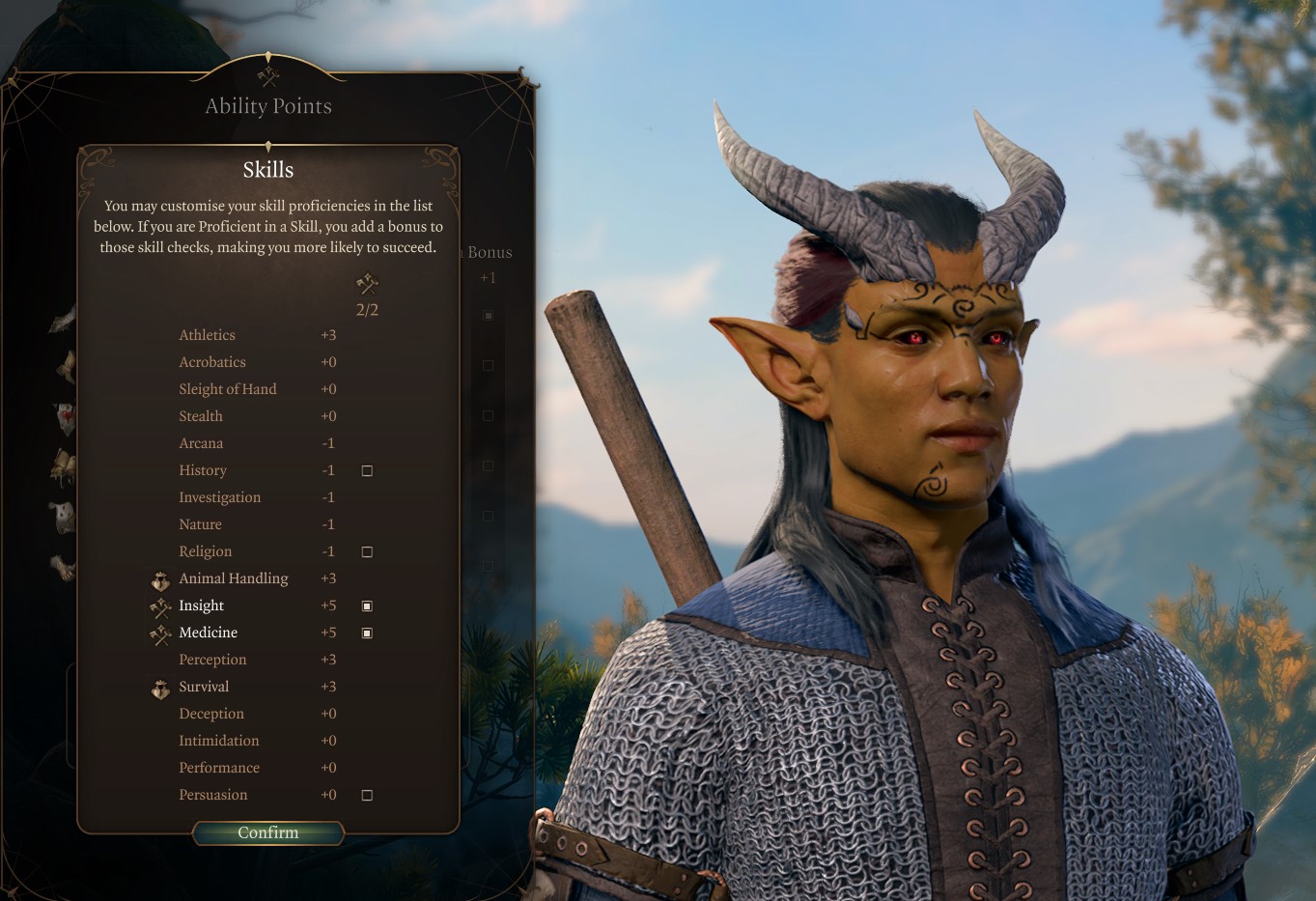
Medicine and Insight are the best skills for the Best Baldur’s Gate 3 Cleric War Domain Build Guide because they complement your class abilities and enhance your effectiveness in various situations. In Baldur’s Gate 3, skills represent the abilities and proficiencies of your character that allow them to perform various actions and interact with the game world. Skills are associated with specific attributes and are used to determine the success or effectiveness of certain actions or abilities. They can be edited during character creation or with companions, during respec or reroll screen.
Here are the skills for War Domain Cleric in Baldur’s Gate 3:
- Medicine – is a Wisdom skill that aids in recognizing symptoms and diagnosing disease.
- Insight – is a Wisdom skill used in dialogue and exploration.
Best Ability Scores for War Domain Cleric
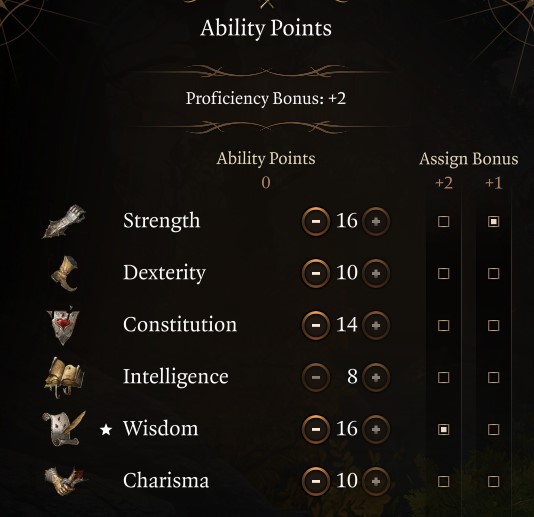
Below is the best ability score to unlock the full potential of the Best Baldur’s Gate 3 Cleric War Domain Build Guide:
| Ability | Score |
|---|---|
| Strength | 16 |
| Dexterity | 10 |
| Constitution | 14 |
| Intelligence | 8 |
| Wisdom | 16 |
| Charisma | 10 |
The most important ability score for the Best Baldur’s Gate 3 Cleric War Domain Build Guide is 16 Wisdom followed by 16 Strength and 14 Constitution. It’s important to land on even numbers and get at least 16 in Wisdom for optimal spell casting. This may seem like an odd score, but our War Domain Cleric build will be using martial weapons (one hand and shield), and the damage scales in effectiveness based on the Strength ability score.
Wisdom is also important because our spells scale in effectiveness with this as well. Lastly, we have a very low Dexterity rating because we will be using heavy armor the entire playthrough and will rely on the Alert feat for Initiative (going first in attack order). While it may seem strange, this is an effective setup to get good damage from both martial attacks and spells.
During character creation, the game will automatically distribute your abilities in the character creation abilities tab. You will need to reprioritize the stats for the chart for the Best Baldur’s Gate 3 Cleric War Domain Build. Simply use the plus-minus in the character creator and make sure you have the suggested race, or the numbers will be off.
Best War Domain Cleric Companions
For Cleric Build, we do not recommend another upfront damage dealer as both you and either Lae’zel or Karlach will fulfill that role. The premise of the build is to have one to two melee fights with a heavy damage dealer, your Cleric providing support. Having range casters and damage dealers will help with crowd control, area damage, and burst at range.
- Lae’zel (Fighter): damage, high survivability, and in-your-face aggression.
- Gale (Wizard): range magic damage, crowd control, and utility spells.
- Astarion (Rogue): High Initiative, damage, lockpicking, and sneaking
When putting your party together, consider companions for not only their combat prowess but also their outside abilities and skills that can influence storytelling, dialogue, and exploration. A balanced party will fit the traditional RPG ‘holy trinity’: Tank, Healer, and DPS. Ideally, in Baldur’s Gate 3, you are going to want one tank, one healer, one melee DPS, and one range DPS. Some classes/subclasses can cover both roles, so feel free to experiment and find out what works best for you.
War Domain Cleric Spell Slots
Here is a list of the War Domain Clerics’ Spell Slots as they progress:
| Cleric Level | 1st | 2nd | 3rd | 4th | 5th | 6th |
|---|---|---|---|---|---|---|
| Level 1 | 2 | 0 | 0 | 0 | 0 | 0 |
| Level 2 | 3 | 0 | 0 | 0 | 0 | 0 |
| Level 3 | 4 | 2 | 0 | 0 | 0 | 0 |
| Level 4 | 4 | 3 | 0 | 0 | 0 | 0 |
| Level 5 | 4 | 3 | 2 | 0 | 0 | 0 |
| Level 6 | 4 | 3 | 3 | 0 | 0 | 0 |
| Level 7 | 4 | 3 | 3 | 1 | 0 | 0 |
| Level 8 | 4 | 3 | 3 | 2 | 0 | 0 |
| Level 9 | 4 | 3 | 3 | 3 | 1 | 0 |
| Level 10 | 4 | 3 | 3 | 3 | 2 | 0 |
| Level 11 | 4 | 3 | 3 | 3 | 2 | 1 |
| Level 12 | 4 | 3 | 3 | 3 | 2 | 1 |
War Domain Cleric Illithid Powers
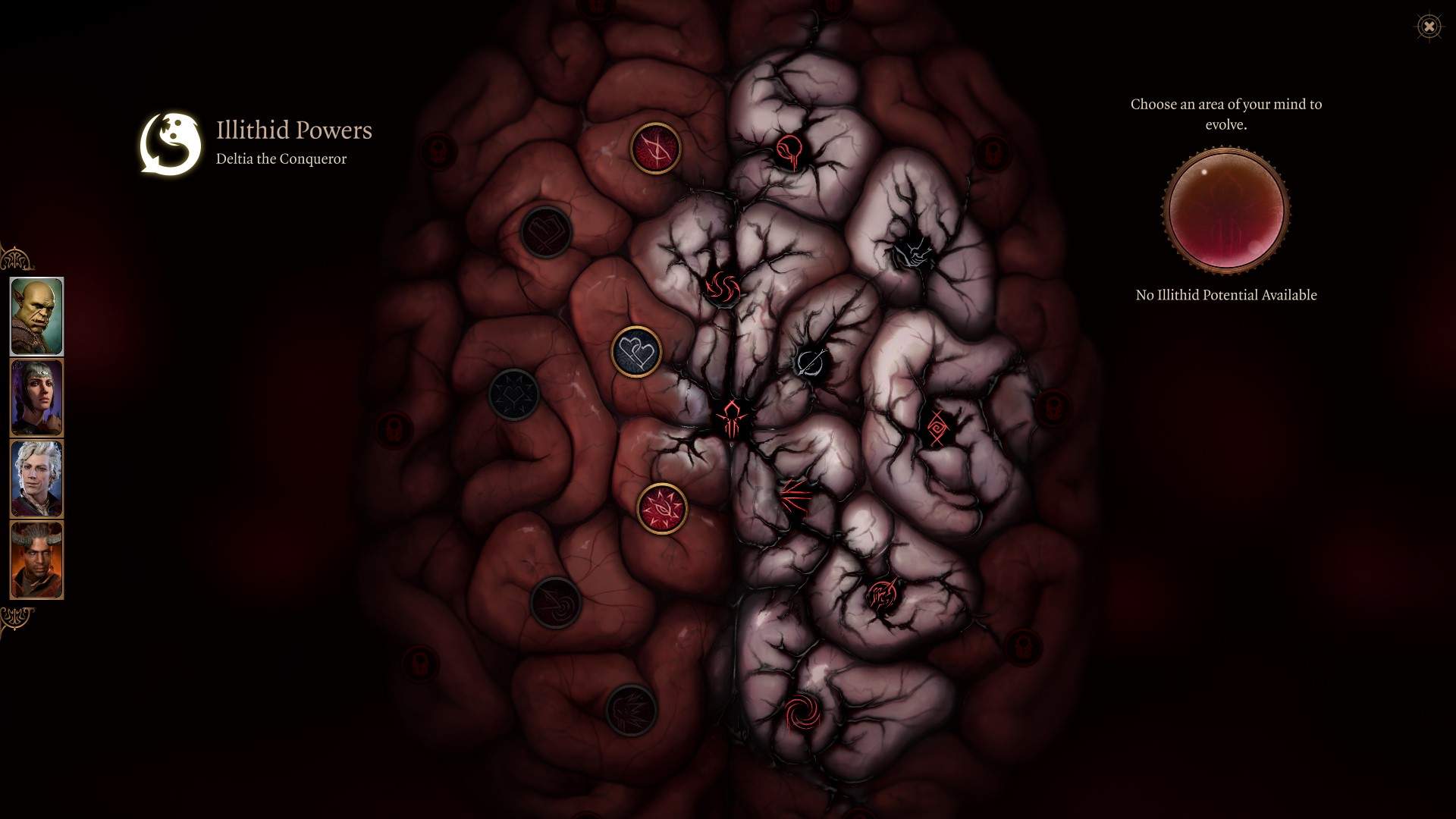
Illithid Powers are unlocked later in the game when you learn more about the Mind Flayers and Tadpoles. You can gain jars of Mind Flayer Parasite Specimens, and consume them to gain one point. This is essentially another skill tree advancement with some very strong powers. If you decide to advance this skill line, these are the choices we suggest.
Here are the best Illithid Powers for the Best Baldur’s Gate 3 Cleric War Domain Build Guide:
| Illithid Powers | Description |
|---|---|
| Luck of the Far Realms | When you make a successful Attack Roll against a foe, you can change that hit into a Critical Hit. |
| Cull of the Weak | When you bring a creature down to fewer hit points than your number of evolved Illithid powers, it dies and all nearby creatures take 1-4 Psychic damage. |
| Psionic Backlash | When an enemy within 9m casts a spell, you can use your reaction to inflict ld4 Psychic damage to the caster per the spell’s level. |
| Blackhole | Area-based suck-in that slows targets. |
| Repulsor | Massive area knockback that can hit friendlies. |
| Charm | This is the priority power you want to obtain because you can force enemies to attack something else. |
Related:
War Domain Cleric Level Progression
| Level | Class | Selection |
|---|---|---|
| 1 | Cleric | Subclass: War, Guidance, Sacred Flame, Thaumaturgy, Guiding Bolt, Cure Wounds, Healing Word, Inflict Wounds |
| 2 | Cleric | Command, Turn Undead, Guided Strike |
| 3 | Cleric | Warding Bond, Magic Weapon, Spiritual Weapon |
| 4 | Cleric | Feat: Savage Attacker, Blade Ward, Silence |
| 5 | Cleric | Animate Dead, Spirit Guardians, Crusader’s Mantle, Destroy Undead |
| 6 | Cleric | Glyph of Warding, War God’s Blessing |
| 7 | Cleric | Guardian of Faith, Stoneskin, Freedom of Movement |
| 8 | Cleric | Feat: Alert, Banishment, Divine Strike: Warmaster |
| 9 | Fighter | Protection Fighting Style, Second Wind |
| 10 | Fighter | Action Surge |
| 11 | Fighter | Subclass: Battle Master |
| 12 | Fighter | Feat: Shield Master |
Alternative War Domain Cleric Build
If you’re looking for an alternative to the War Domain Cleric that prioritizes durability and battlefield control, consider a tank-style build built around the Light Domain subclass. Instead of focusing on raw weapon-based offense, this approach relies on area control and defensive utility, with the Luminous Armour playing a central role. Found early in Act 1, this armor radiates a passive aura that applies Disadvantage on enemy attacks, allowing your Cleric to act as a front-line buffer who weakens foes simply by standing near them.
When combined with Spirit Guardians, this build becomes a zone-denial powerhouse, chipping away at clustered enemies while slowing them and reducing their combat effectiveness. The synergy between Light Domain spells and the Radiating Orb effect creates a highly disruptive presence in melee combat. This setup excels in high-pressure scenarios and is particularly effective in Tactician or Honour Mode, where controlling the battlefield and limiting enemy damage output are key to survival.
| Level | Class | Selection |
|---|---|---|
| 1 | Cleric | Subclass: Light, Thaumaturgy, Guidance, Sacred Flame, Command, Guiding Bolt, Sanctuary, Healing Word |
| 2 | Cleric | Shield of Faith |
| 3 | Cleric | Spiritual Weapon |
| 4 | Cleric | Feat: Alert, Blade Ward, Aid |
| 5 | Cleric | Spirit Guardians, Swap Healing Word for Mass Healing Word |
| 6 | Fighter | Multiclass: Fighter, Defence Fighting Style |
| 7 | Fighter | Action Surge |
| 8 | Fighter | Subclass: Eldritch Knight, Booming Blade, Fire Bolt, Shield, Thunderwave, Longstrider |
| 9 | Fighter | Feat: Ability Improvement +2 Wisdom, Chromatic Orb |
| 10 | Cleric | Multiclass: Cleric, Protection from Energy, Glyph of Warding |
| 11 | Cleric | Drop Shield of Faith, Add Freedom of Movement and Death Ward |
| 12 | Cleric | Feat: War Caster, Banishment |
Level 1
At Level One follow our character creation steps above to pick all correct background, race, skills, and ability score distributions focusing on Wisdom and Strength. You want to use heavy armor, along with a one-handed weapon and shield. For Clerics, you’ll be choosing your subclass at Level One, right in the character creator. The premise of the build is to use spells in combination with marital attacks for damage. At later levels, you can use bonus actions for weapon attacks giving you two great sources of damage.
Also at Level One, you will unlock three cantrips and pick three prepared spells. Cantrips are reusable and don’t require a spell slot resource. Prepared spells can be swapped in and out before combat, so use the loadout at the end of the level for a helpful guide.
Cantrips Selection
- Sacred Flame: Conjure a flame-like radiance that deals 1d8 Radiant. This Cantrip acts with a very low damage range ability that can be used without a spell slow.
- Guidance: Bestow guidance upon an ally. They gain a +1d4 bonus to Ability Checks. This spell is critical during dialogue checks and is very useful outside of combat.
- Thaumaturgy: Gain Advantage on Intimidation and Performance Checks. This is another helpful noncombat-related cantrip.
Prepared Spells
- Guiding Bolt: 4d6 Radiant damage that grants Advantage on the next Attack Roll against the target. This is very high damage early and helpful because of the Advantage component. Consider this your main offensive spell early on for damage.
- Cure Wounds: 1d8 heal requiring you to touch a creature to heal it. A melee-based heal that isn’t that powerful but at early levels it can be combined with Healing Word for two heals in one turn.
- Healing Word (Domain Spell): 1d4 Heal a creature you can see up to 18m away with bonus action. Since this is a bonus action heal, you can combine it with an action-based heal like Cure Wounds or others to do two heals in one turn.
- Inflict Wounds: 3d10 damage necrotic. Used in melee range for good damage.
Subclass Features
- Free Domain Spell Divine Favour: Your prayer empowers you with divine radiance. Your weapons deal an additional 1d4 Radiant damage.
- Free Domain Spell Shield of Faith: Surround a creature with a shimmering field of magic that increases its Armour Class by 2.
- War Priest: When you make an unarmed or weapon attack, you can spend a War Priest Charge to make an additional attack as a bonus action.
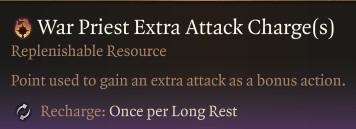
Choosing the War Domain subclass for Clerics also unlocks Heavy Armour Proficiency, as well as Martial Weapon Proficiency.
War Domain Cleric Gameplay Explained
There’s a lot to explain with this War Domain Cleric build. The main premise is to use both your action and bonus action every turn. Ideally, you want to use your Action for high-powered spells. At a lower level, Guiding Bolt at range and Inflict Wounds in melee will deal amazing damage. In later games, you can use your spell slots and spells to summon allies to help you fight. This can be undead, Spiritual Weapon, and Guardian. You combine that with an occasional burst heal and range damage ability.
You should be using your bonus action for multiple attacks with your weapon. This is good at later levels when we get access to gear and advanced spells. You can use your action once to attack, then activate War Priest to consume the bonus action for another attack. This is one of the main issues with the Cleric is the lack of action and bonus action utility. This subclass gives us a great tool to counter the weakness and get more damage each turn.
For now, work on getting heavy armor and one hand and shield. Your turn will be offensive-focused depending on your range, generally use spells. Shy away from cantrips for damage unless you cannot make it in melee range. You want to take damage for teammates especially later in the game with much better equipment and very high Armour Class (AC). The higher your AC, the more likely you are to avoid it. This will blend spells, martial weapon attacks, and high survivability.
War Cleric Gameplay & Priorities
During the early phase of BG3, your War Cleric should equip a One-Handed weapon and Shield as soon as possible. This will help your defensive potential immensely. Moreover, rely on cantrips for damage when out of spell slots like Sacred Flame. Spell casting can be tough at the start of Baldur’s Gate 3 with limited spell slots. Moreover, look to acquire Elixir of Hill Giant Strength, Potion of Speed, and Oil of Accuracy consumables. These three consumables “stack” allowing for massive damage!
Your overall priority with the War Cleric build is the following:
- Complete Prologue
- Recruit Companions
- Unlock Withers, respec companions to proper class/ability score
- Collect the Necromancy of Thay (important in Act 3)
- Reached Hollowed City/Druid Grove
- Sell, Stock up, complete quests
- Unlock summons, Scratch, Shovel
- Progress to level 5
- Reach Underdark and Grymforge
- Check all Permanent Bonuses in Act 1 and the best Gear
Following these steps ensures a strong foundation, especially if you plan on playing solo or on Honour Mode difficulty.
War Domain Cleric Level 1 Prepared Spells: Guiding Bolt, Cure Wounds, Healing Word, Inflict Wounds
Level 2
At level two your spells will largely stay the same. You will have prepared spells and can pick up to 5 to learn and swap out outside of combat the ones you’ve already learned. Next, you will receive Guided Strike via your subclass and we recommend you take the spell Command.
Prepared Spells
Command: Command a creature to flee, move closer, freeze, drop to the ground, or drop their weapon 18m requiring concentration. This is a powerful area-based crowd-control effect that can force weapons to drop. Use this early in the game when overwhelmed with enemies.
Subclass Features
- Turn Undead: Inflicts Turned. Present your holy symbol and pray. Each undead that can see or hear you is forced to flee from you.
- Guided Strike: Reaction. You gain a +10 bonus to your Attack Roll.
Gameplay at level 2 remains largely the same with added utility for crowd control with Command. You can use Guided Strike gives a massive +10. You can turn reactions via your spell book and scroll to the right. This will ask you if you want to use the reaction. It’s important because it will consume your Channeled Divinity resource, which at this level you have once. You can replenish it during short rest, but it’s a once-per-fight resource at this level. You don’t want to waste it when a goblin has 2 health remaining. Make good use of this when you need that extra strike and you have a high percentage to land the hit.
War Domain Cleric Level 2 Prepared Spells: Guiding Bolt, Cure Wounds, Healing Word, Inflict Wounds, Command
Level 3
Reaching Level 3 will unlock two level 2 spells and an additional level 1 spell, as well as two subclass spells. Below is a list of the new spells and subclass features for War Domain Cleric at level 3.
- Warding Bond (spell selection): Ward is an ally. They gain Resistance to all damage and a +1 bonus to their Armour Class and Saving Throws. Each time the target takes damage, the spellcaster takes the same amount of damage.
- Magic Weapon (subclass feature): Infuse a weapon with arcane energy. The weapon becomes magical, receiving a +1 bonus to Attack and Damage Rolls.
- Spiritual Weapon (subclass feature): Summon a floating, spectral weapon that attacks your enemies alongside you for 10 turns
The biggest addition to your arsenal at this level is Spiritual Weapon. This ability summons a limited-time, 10-turn ally. You can select different types which give you specific abilities. Take one that fits your needs and experiment if you need more damage (lacerate) or more crowd control (Daze). The best part of this is it costs a bonus action, not an action, and does NOT require concentration. You can pair this with a spell a few levels from now Spiritual Guardian and have two allies on the battlefield at once while you’re on the offensive attacking.
War Domain Cleric Level 3 Prepared Spells: Guiding Bolt, Cure Wounds, Healing Word, Inflict Wounds, Command, Warding Bond
Level 4
At level four, the Cleric gets one cantrip, one more prepared spell, and a feat or ability improvement. Below is a list of the new spells and subclass feature for War Domain Cleric at level 4:
- Blade Ward (cantrip selection): Take only half of the damage from Bludgeoning, Piercing, and Slashing attacks. This is a decent cantrip when expecting incoming melee damage.
- Silence (spell selection): Create a sound-proof sphere. All within are Silenced and Immune to Thunder damage.
- Savage Attacker (feat selection): When making weapon attacks, you roll your damage dice twice and use the highest result.
At level 4 we are going to take a melee-focused feat Savage Attacker which helps us do more damage with weapon attacks. At this level, our spells will be doing big damage as well. Later in levels, we want to use gear that increases our overall stat or potions like Hill Giant Strength. This gives you +21 strength until a long rest. It’s a great way to not use your feat to increase Strength and use a consumable for a huge buff to weapon attack damage. We will get another feat at 8 and 12.
War Domain Cleric Level 4 Prepared Spells: Guiding Bolt, Cure Wounds, Healing Word, Inflict Wounds, Command, Warding Bond, Silence
Level 5
At level five, the War Cleric gets two free spells via your sublcass and you get to pick a level 3 spell. Below is a list of the new spells and subclass feature for War Domain Cleric at level 5:
- Animate Dead (spell selection): Create an undead servant from a corpse.
- Spirit Guardians (sublcass feature): Call forth spirits to protect the area around you. Nearby enemies take 3 – 24 Radiant damage or 3 – 24 Necrotic damage per turn, and their Movement Speed is halved. On Save: Targets still take half damage.
- Crusader’s Mantle (sublcass feature): Radiate a holy power that emboldens nearby allies. Their weapon attacks deal an additional 1∼4 Radiant damage.
- Destroy Undead (Class feature): When you’ve successfully Turned an undead using Turn Undead, it also takes 4d6 Radiant damage.
At this level you get two additional summons you can take advantage of. Animate dead is a fun spell because it consumes a corpse outside of combat and you get a follower to join you in combat until a long rest. This spell also doesn’t cost concentration and you can bring more to fight for you with just the cost of a spell slot. Usually, I go back to a previous fight and look for corpses to animate.
Next is Spiritual Guardian which creates a small area around you and does great damage. This is a useful spell to cast if you are in a 3m radius of one or more enemies. It requires concentration so don’t cast multiple spells with it or you’ll lose the effect. Consider this a go-to spell at this level for when near or engaging with one or more enemies.
War Domain Cleric Level 5 Prepared Spells: Guiding Bolt, Cure Wounds, Healing Word, Inflict Wounds, Command, Warding Bond, Silence, Animate Dead
Level 6
At level six for a War Cleric, you gain another level 3 spell, and another Channel Divinity Charge called War God’s Blessing. Below is a list of the new spells and subclass features for War Domain Cleric at level 6:
- Glyph of Warding (spell selection): Inscribe a circle of arcane glyphs on the ground that triggers a magical effect when stepped on by an enemy.
- War God’s Blessing (subclass feature): Endow a nearby ally with the glory of your god to grant them a +10 bonus to their Attack Roll.
The addition of Glyph of Warding gives the class a range area-based damage spell. I typically use cold or frost damage because of the status effect it can cause and possibly knock Prone. War God’s Blessing is useful if playing with another weapon-based damage dealer. You can buff them with your Channel Divinity and it can be useful, though you’ll mostly be using this for yourself as an offensive Cleric.
War Domain Cleric Level 6 Prepared Spells: Guiding Bolt, Cure Wounds, Healing Word, Inflict Wounds, Command, Warding Bond, Silence, Animate Dead, Glyph of Warding
Level 7
At level 7, the War Cleric gains one level 4 spell slot, and two subclass-specific spells: Stoneskin and Freedom of Movement. Below is of the War Domain Cleric progression at level 7:
- Guardian of Faith (spell selection): Hostile creatures within a 10-ft radius of the created guardian must succeed on a Dex. save or take 20 radiant damage. This summonses a created guardian which cannot move but deals damage in a 10ft radius. Every time it does damage, it takes damage. The nice thing about this spell is it can be used in conjunction with a Spiritual Weapon. One is an action, one a bonus action and BOTH do not require concentration. So, on turn one, you can drop down Guardian in the middle of the action along with Spiritual Weapon.
- Stoneskin (subclass spell): Turn a creature’s flesh hard as stone. It gains Resistance (half the damage) of all non-magical Bludgeoning, Piercing, and Slashing damage.
- Freedom of Movement (subclass spell): The Target’s movement is unaffected by difficult terrain, spells or water. This is a beneficial spell for movement in or outside of combat.
War Domain Cleric at Level 7
The most important addition at this level is the Guardian of Faith. This 10 ft radius summon creature does great damage. It can return fire, opportunity attack, and just harass people in range. The downside is, it cannot move. As powerful as this spell is, it does not require concentration. Meaning, that you can stack animated dead, spiritual weapons, and guardians of faith on top of each other. Spiritual Weapon bonus action, Guardian of Faith is an action and Animate Dead can be cast out of combat. Turn one, if you use this spell you could have three allies possibly fighting for you alongside your high melee damage.
War Domain Cleric Level 7 Prepared Spells: Guiding Bolt, Cure Wounds, Healing Word, Inflict Wounds, Command, Warding Bond, Silence, Animate Dead, Glyph of Warding, Guardian of Faith
Level 8
At level 8 the War Cleric gets Divine Strike, an additional level 4 spell slot, Divine Strike: Warmaster, and a feat. Below is of the War Domain Cleric progression at level 7:
- Banishment (spell selection): Temporarily Banish your target to another plane of existence.
- Divine Strike: Warmaster (subclass feature): Once per turn deal 1-8 in addition to your melee weapons damage.
- Alert (feat selection): You gain a +5 bonus to Initiative and can’t be Surprised.
At this level we get a powerful crowd control Banishment. You want to use this with one dominant enemy that will likely kill one or more friendlies. This will just make them unavailable for two turns while you can control, destroy, and heal up when it return. We get a feat at this level and I suggest taking Alert which may seem odd.
The major issue with the War Domain Cleric at this level is low Dexterity which equals going nearly last in the turn order. The one thing that can ruin your build and gameplay experience is getting crowd-controlled, disarmed, knocked prone, etc. Then all the fancy spells, skills, and weapons won’t mean anything. We will rely on potions, consumables, and gear to increase our ability scores and the alert feat is slept on. This will give you a huge advantage in turn order along with not being surprised which skips your first turn.
War Domain Cleric Level 8 Prepared Spells: Guiding Bolt, Cure Wounds, Healing Word, Inflict Wounds, Command, Warding Bond, Silence, Animate Dead, Glyph of Warding, Guardian of Faith, Banishment
Level 9
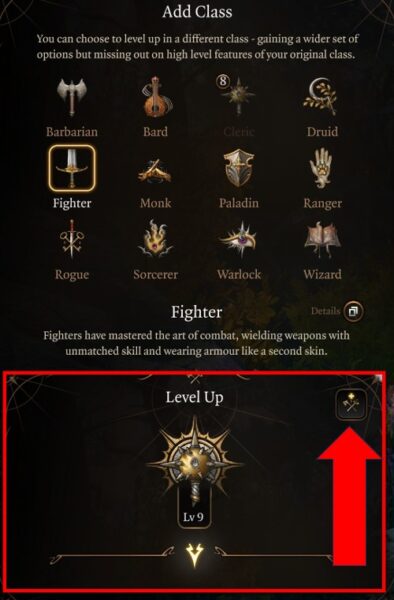
At level 9 we suggest multi-classing to a Fighter. The reason being, that this subclass will give us access to Action Surge and Fighting Style. Action Surge solves the biggest problem with the Cleric, lack of Extra Attack or Extra action. This is granted after 2 levels and you can use it once per fight. Moreover, the Fighting Style will give us a lot of options at the end game. You can even run a two-handed Greatsword and play very similar to a Barbarian and Paladin with a fight styling and Great Weapon Master feat at level 12.
The first level of multi-class seems weak, but at level 3 we select a subclass and get two pick battle maneuvers which helps us with crowd control without requiring a spell or concentration. The only downside from multi-classing at this level is losing out on level 5 and level 6 spells. However, the War Domain subclass doesn’t make the best use of higher-level spells and if you’re playing a martial melee build, that can cast spells, and summon creatures, adding more melee focus from here on out is the play.
War Domain Cleric unlocks the following if you Multiclass into Fighter:
- Second Wind (class feature): this skill is unlocked at level one Fighter and is a mediocre heal that is useful during the start of the game. You can use a bonus action, though most potions outperform it.
- Protection Fighting Style (class feature): When a creature you can see attacks a target other than you that is within 5 feet of you, you can use your reaction to impose a disadvantage on the attack roll. You must be wielding a shield.
If you want to use a two-handed greatsword, Warhammer, etc., take the Great Weapon Fighting Style and take the Great Weapon Master feat at level 12. This build is centered on one hand and shield but you have options now with Fighter class.
War Domain Cleric Level 9 Prepared Spells: Nothing changes from here on out with multiclassing
Level 10
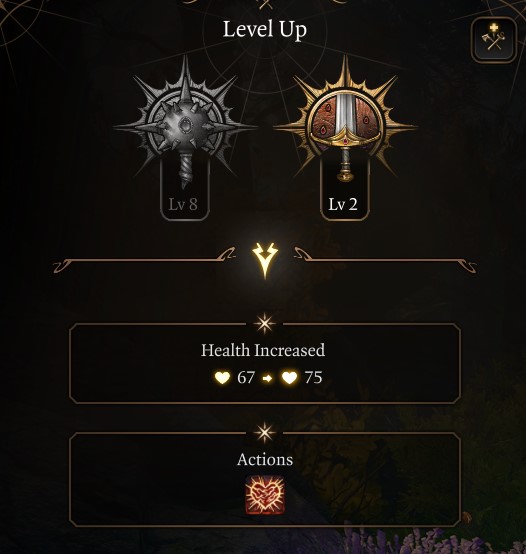
At level 10 with two levels into Fighter, you unlock Action Surge. Immediately gain an extra action to use this turn. This ability does not require an action or a bonus action, but it’s a once-per-short rest resource. You want to make good use of it, particularly if you need another attack, crowd control, or just one more action to get that tough enemy down. Once you start using this, you will love it, and one of the reasons Fighter is so strong.
War Domain Cleric Level 10 Prepared Spells: Same as before
Level 11
At level 3 in Fighter, we unlock the subclass selection and we want to take Battle Master. This will unlock yet another resource called Superiority Dice. You will get four which recharge on short rest similar to our other resources. You will be able to select three Manoeuvres and here’s what we suggest:
- Disarming Attack: Spend a superiority die to make an attack that deals additional damage and possibly forces the target to drop the weapons they are holding.
- Goading Attack: Deal an additional 1d8 and attempt to goad the target into attacking you. Target receives a Disadvantage on attacking any other creature.
- Riposte: When a hostile creature misses you with a melee attack, expend a superiority die to retaliate with a powerful strike that deals an additional 1d8 damage.
War Domain Cleric at Level 11
These abilities add an extra effect to your weapon damage either melee or range. Disarming is perfect for weapon-based characters like a Fighter or a Barbarian that rely on damage with weapons. If you drop their weapon and pick it up, you essentially destroy their entire build and damage. Goading is great for forcing enemies to attack you. If you get the Legendary Shield suggested in the gear section, you can completely dominate the opposition by forcing them to attack you and hammering them with reactions.
Lastly, we get to Riposte, which will do extra damage at the expense of a superiority die if someone misses you. This build will have very high AC with heavy and legendary gear and with Goading people will be forced to attack you. If they hit you, you can react with a shield, if they miss, you do free damage. It’s an amazing setup that doesn’t cost any action and does free damage.
War Domain Cleric Level 11 Prepared Spells: Same as before
Level 12
We have reached the last level in Baldur’s Gate 3! You unlock another feat at this level and I suggest Shield Master.
Shield Master: You gain a +2 bonus to Dexterity Saving Throws while wielding a shield. If a spell forces you to make a Dexterity Saving Throw, you can use a reaction to shield yourself and diminish the effect’s damage. On a failed Saving Throw, you only take half damage. On a successful Saving Throw, you don’t take any damage.
As stated in level 11, you can use Goading and Riposte for free damage. You can also get an item that boosts your Dexterity up to 18 and in conjunction with this Shield Master bonus will be very hard to hit. This reduces damage significantly while you maintain your offensive pressure.
Use your spells mainly for range damage, crowd control, and summons. Your source of damage is the +10 Attack via Guided Strikes. You can do this two times per short rest. Use weapon attacks along with Superiority Dice to disarm enemies. And lastly, use your third resource pool for two melee attacks in one turn. With the recommended feats, ability score, race, and spells this will be a different yet highly affected War Domain Cleric.
War Domain Cleric Level 12 Prepared Spells: Same as before – Guiding Bolt, Cure Wounds, Healing Word, Inflict Wounds, Command, Warding Bond, Silence, Animate Dead, Glyph of Warding, Guardian of Faith, Banishment
Best Gear for War Domain Cleric
In Games like Baldur’s Gate 3, you’ll explore the world, loot chests and your enemies’ dead bodies, and complete quests and all those activities can reward you with useful items, potions, armor, weapons, scrolls, and much more. There are three Acts in BG3, and the Best Baldur’s Gate 3 Multiclass Cleric Build includes suggested sets and alternatives for Act 1 and Act 3.
Beginner: Act 1
Here’s the best beginner gear for the Best Baldur’s Gate 3 Cleric War Domain Build Guide:
| Gear Slot | Best Gear Item | Effect |
|---|---|---|
| Head | Haste Helm | Increase Movement |
| Cape | – | |
| Chest | Adamantine Splint Armour | 18 AC |
| Gloves | Hellrider’s Pride | Heals give resistance |
| Boots | Disintegrating Night Walkers | Mobility and Misty Step |
| Necklace | Amulet of Misty Step | Free Misty Step |
| Ring | Ring of Absolute Force | Thunderwave Spell |
| Ring | Crusher’s Ring | Increased Movement |
| Weapon 1 Main Hand | Adamantine Longsword | +1 Longsword |
| Weapon 1 Off-Hand | Glowing Shield | 8 HP when below 50% Health |
Below is the best Act 1 Armor, Weapons, and Equipment for War Cleric in BG3:
- Haste Helm: Found in Act 1 Blighted Village (X:32, Y:403)(alternative Grymskull Helm).
- Adamantine Splint Armour: Crafted in the Adamantine Forge (alternatives Luminous Armour, or Githyanki Half Plate).
- Hellrider’s Pride: Can be bought, stolen, or earned from Zevolr (alternatives Gloves of Missile Snaring, or Gloves of Hail of Thorns).
- Disintegrating Night Walkers: Can be taken from Nere, at the Grymforge (alternatives Boots of Striding, or Boots of Aid and Comfort
- Amulet of Misty Step: Found in a Gilded Chest (X386 Y8) in a Defiled Temple (alternatives Moondrop Pendant, or Amulet of Restoration).
- Crusher’s Ring: Can be looted or stolen from Crusher in the Goblin camp (alternatives Strange Conduit Ring, or Ring of Absolute Force).
- Ring of Absolute Force: Dropped by Sergeant Thrinn in Grymforge (alternatives The Whispering Promise, or Ring of Colour Spray).
- Adamantine Longsword: Crafted in the Adamantine Forge (X:-137, Y:558) (alternatives Phalar Aluve, or Githyanki Longsword).
- Glowing Shield: In a chest on a slope behind the goblin camp. (X: -54, Y: 462)(alternatives Wood Woad Shield).
Advanced: Act 3 End Game
The following table presents the best advanced and end-game gear for the Best Baldur’s Gate 3 Cleric War Domain Build Guide:
| Gear Slot | Best Gear Item | Effect |
|---|---|---|
| Head | Helm of Balduran | Cannot Be Stunned |
| Cape | Mantle of the Holy Warrior | Free Crusader’s Mantle |
| Chest | Helldusk Armour | 21 AC |
| Gloves | Gauntlets of Hill Giant Strength | 23 Strength |
| Boots | Helldusk Boots | Cannot be Moved |
| Necklace | Amulet of Greater Health | 23 Constitution |
| Ring | Killer’s Sweetheart | Auto Critical |
| Ring | Ring Of Regeneration | Passive healing |
| Weapon 1 Main Hand | The Blood of Lathander | Sunbeam and Healing |
| Weapon 1 Off-Hand | Viconia’s Walking Fortress | 3 AC, Reflect Spell |
Below is a list of the best Act 3 Gear for the War Domain Cleric Build in Baldur’s Gate 3:
- Helm of Balduran: Found on an altar next to Ansur in The Wyrmway, Act 3. (Alternative Helldusk Helmet).
- Mantle of the Holy Warrior: Sold by Vicar Humbletoes in Stormshore Tabernacle (Alternative Cloak of the Weave, or Cloak of Protection).
- Helldusk Armour: Looted from Raphael in the House of Hope (Alternative Armour of Persistence).
- Gauntlets of Hill Giant Strength: Obtained in Archive of the House of Hope (alternatives Helldusk Gloves, or Gloves of Soul Catching).
- Helldusk Boots: Chest on the top floor of Wyrm’s Rock Fortress (Alternative Disintegrating Night Walkers).
- Amulet of Greater Health: Archive in the House of Hope (Alternative Amulet of the Devout, or Spellcrux Amulet).
- Killer’s Sweetheart: Obtained from the Gauntlet of Shar in Act 2 (Alternative Ring of Protection, Risky Ring).
- Ring Of Regeneration: Sold by Rolan at Sorcerous Sundries (Alternative Ring of Free Action, Shifting Corpus Ring).
- The Blood of Lathander: The Blood of Lathander quest in Act 2 (Alternative Selûne’s Spear of Night).
- Viconia’s Walking Fortress: Looted from Viconia DeVir during Shadowheart’s companion quest in Act 3 (Alternative Shield of Devotion).
Best Consumables, Potions, and Items for War Domain Cleric
Consumables are items that can be used once and then destroyed. They are typically used to restore health or other resources. Some common types of consumables include potions, scrolls, food, drinks, and arrows.
The following list represents the best individual use consumable items that will aid in the Best Baldur’s Gate 3 Cleric War Domain Build Guide:
- Elixir of Bloodlust: Once per turn when you kill a foe, you gain HP 5 temporary hit points and an additional action.
- Elixir of Hill Giant Strength: Increases Strength ability score to 21 until Long Rest.
- Potion of Speed: Gain extra action, +2 AC, Advantage on Dexterity Saving Throws, and double movement speed.
- Drow Poison: Weapon poison that adds Constitution Saving Throw or becomes Poisoned and falls Asleep.
- Potion of Flying: Drink to gain a flying speed of 60ft for one hour.
- Elixir of Heroism: Gain 10 temp HP and become Blessed until long rest.
- Potion of Greater Healing: 4d4 + 4 hit points restored.
- Oil of Accuracy: Coat Weapon. Bonus of +2 in Attack Rolls.
- Elixir of Vigilance: Drink to gain a +5 bonus to Initiative and you can’t be Surprised.
- Elixir of Darkvision: (only non-Darkvision race): Drink to gain the ability to see in the dark up to 12m.
Permanent Bonuses
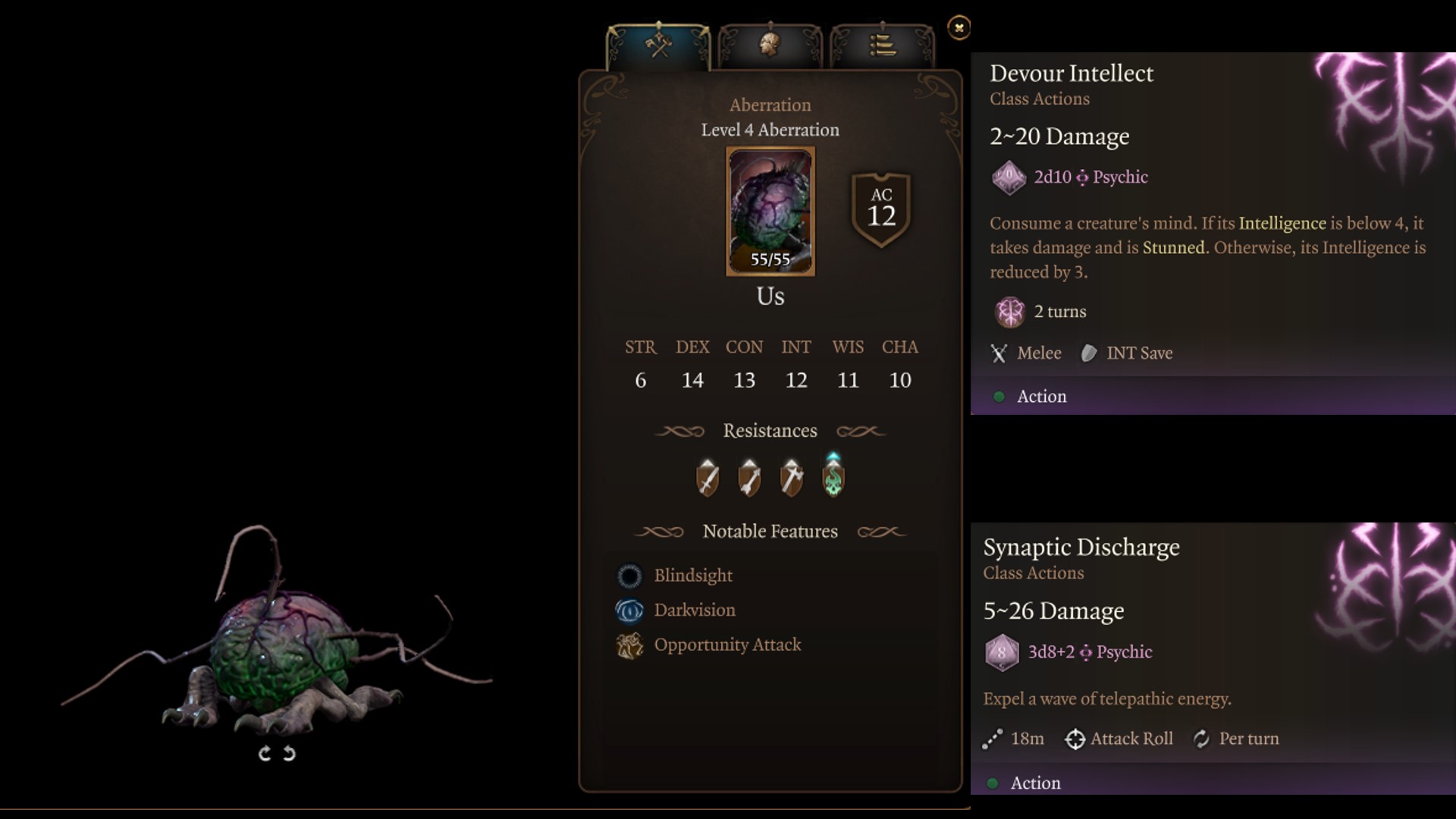
Throughout Baldur’s Gate 3, you will have the ability to gain permanent bonuses to your character. These can grant additional spells, ability scores, and other bonuses. Permanent Bonuses are not displayed throughout the campaign but are vital to increase overall combat performance. We have all permanent bonuses here in a guide, but the most important ones for you to collect are listed below.
| Act 1 | Act 2 | Act 3 |
|---|---|---|
| Auntie Ethel’s Hair: Gain +1 to an Ability Score. | Potion of Everlasting Vigour: Gain +2 Strength. | Mirror of Loss – +2 to an Ability Score of your choice. |
| Awakened: Use illithid powers as a Bonus Action. | Slayer Form: Ability to transform into the Slayer. | Partial Ceremorphosis: Access to tier 3 illithid Powers. |
| Scratch: Gain Find Familiar Scratch. | Summon Us: Allows you to summon Us. | Sweet Stone Features: Blessed permanent. |
| Cheeky Quasit: Gain Summon Quasit Shovel. | Statue of the Gods: +2 to Saving Throws | |
| Loviatar’s Love: 30% Hit Points or less, you gain a +2 bonus to Attack Rolls and Wisdom saving throws. | ||
| Necromancy Of Thay: access to powerful spells in Act 3. | ||
| Volo’s Ersatz Eye: See Invisibility |
Best Permanent Bonuses for War Doman Cleric in Baldur’s Gate 3
War Cleric Combat, Gameplay Tips, and Tricks
Here are 10 gameplay tips and tricks for playing a War Domain Cleric in Baldur’s Gate 3:
- Inflict Wounds: this is your highest damage spell early, then transition to more weapon attacks as you progress.
- Big Attack: Use a Guided strike for a +10 attack when you need it.
- Summon: Use a combination of Spiritual Weapon, Guardian, and Animate Dead for free allies.
- Crowd Control: CC opponents with Blind, and Command to take less damage overall.
- Bonus Action: Use your bonus action damage dealing with subclass feature.
- Guiding Bolt: Early on this is your big nuke spell and it’s wise to use it on the first turn when teammates don’t need a heal.
- AOE: use a Smokepowered Bomb or Glyph of Warding for area damage.
- Consumables: Take advantage of a Potion of Speed when you need multiple actions per turn.
- Scrolls: Keep scrolls of powerful spells with you if you lack Wisdom stat or spell slots.
- Range: Backbar a bow just so you can use attacks when out of spell slots.
Remember, this build guide serves as a foundation, and you can always adapt it to suit your preferences and the needs of your campaign. Enjoy playing as a formidable the Best Baldur’s Gate 3 War Domain Cleric Build Guide!
Light Domain Cleric Class Changes in Patch 7 for BG3
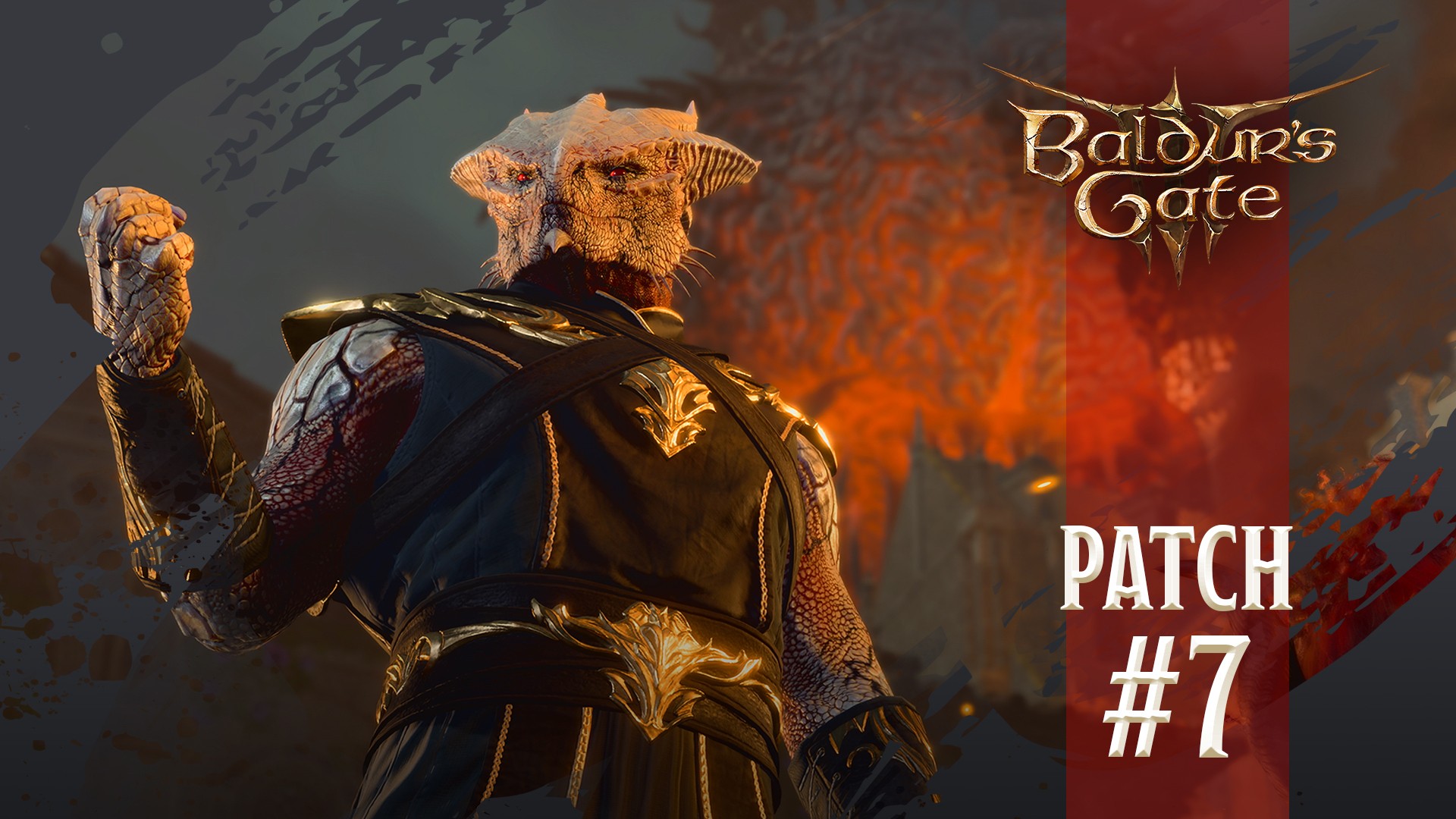
The Light Domain Cleric subclass received no changes in Patch 7 of BG3. Furthermore, most builds, combat, and gameplay elements remained untouched in Patch 7. Therefore, if you are familiar with the class, almost all remain the same.
Larian Studios’ main focus in this patch is mods and new cinematics. The game now features a modding toolkit and an in-game mod manager, allowing players to create and install mods directly within the game. This update is intended to hand over creative control to the community, enabling players to produce unique content and continue the story in new ways. This best Light Domain Cleric Build Guide remains unchanged, mainly in Baldur’s Gate 3 Patch 7.
Best Baldur’s Gate 3 War Cleric Build Summary Guide
Subclass War Domain
Armor: Heavy
Weapons: One Hand & Shield
Ability Score
- Strength 16
- Dexterity 10
- Constitution 14
- Intelligence 8
- Wisdom 16
- Charisma 10
Level Progression
- Level 1 – Guiding Bolt Damage Spell
- Level 2 – Guided Strike
- Level 3 – Spiritual Weapon Class Spell
- Level 4 – Savage Attacker Feat
- Level 5 – Animate Dead and Spiritual Guardian
- Level 6 – Glyph of Warding
- Level 7 – Guardian of Faith
- Level 8 – Alert Feat
- Level 9 – Multi-class Fighter
- Level 10 – Fighter Action Surge
- Level 11 – Fighter Superiority Dice
- Level 12 – Shield Master Feat
Looking For More About Baldur’s Gate 3?
Thank you for reading Best Baldur’s Gate 3 War Domain Cleric Build Guide. We provide the latest news and create guides for Baldur’s Gate 3. Also, watch me play games on Twitch or visit my YouTube channel!
 Reddit
Reddit
 Email
Email
